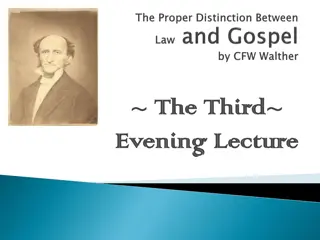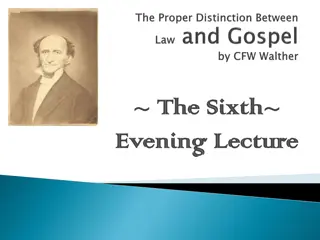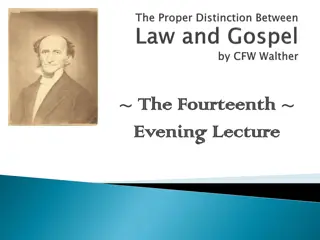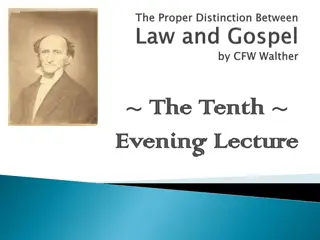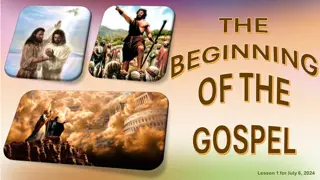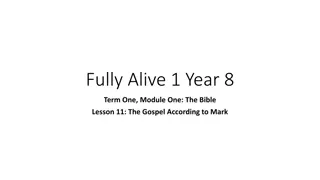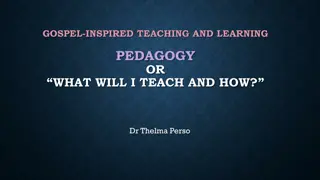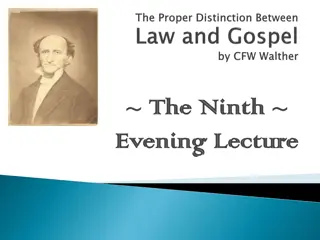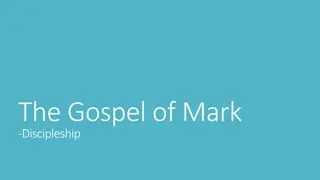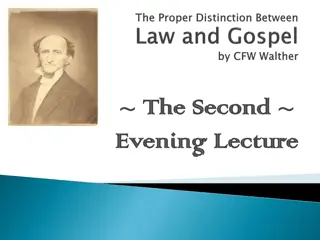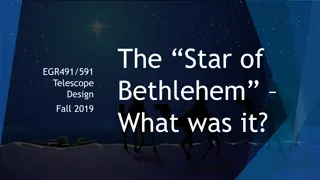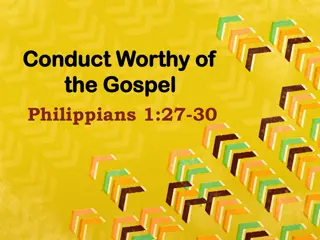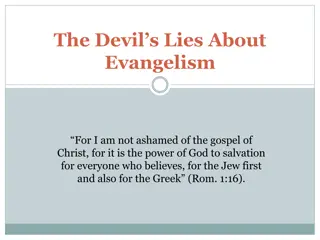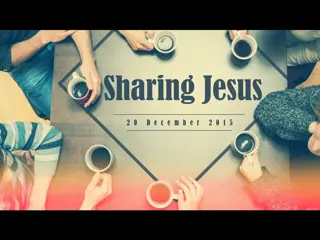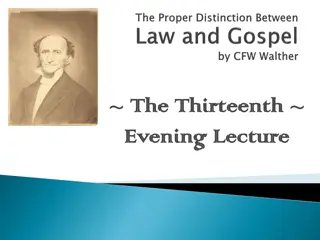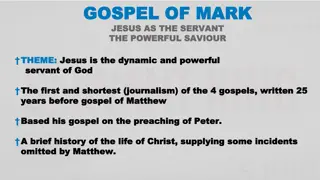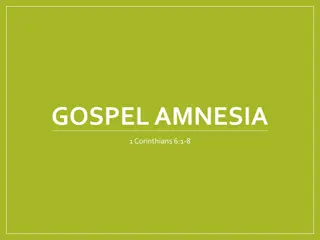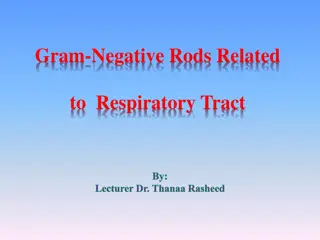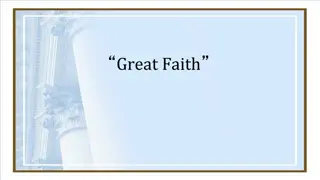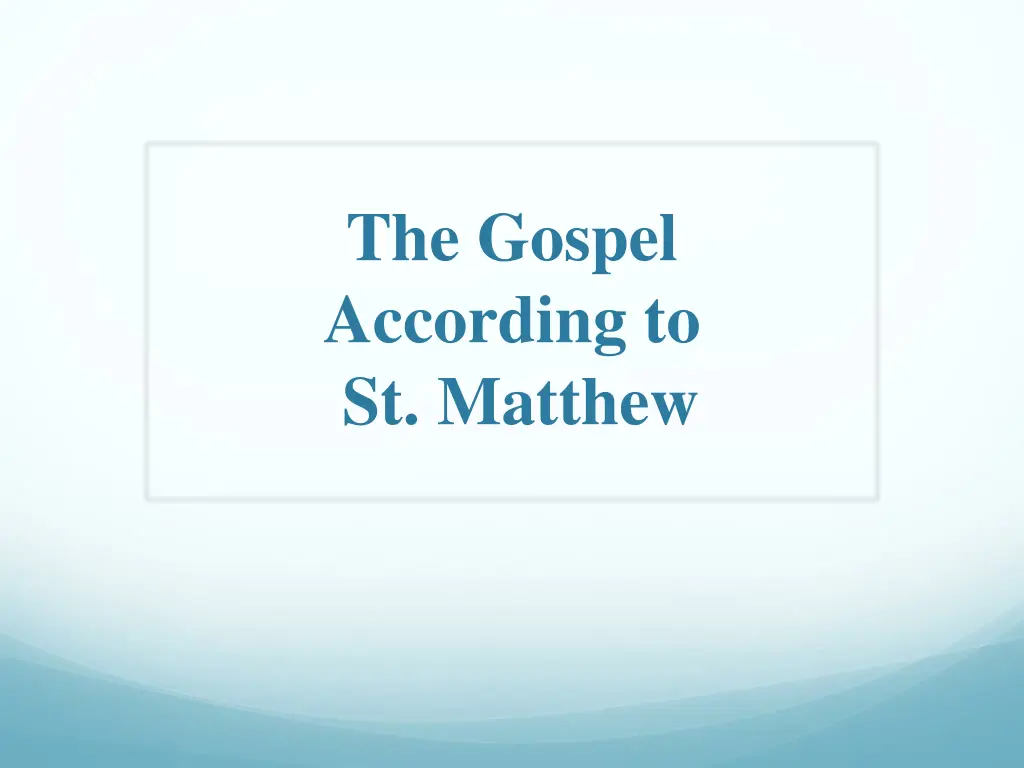
The Gospel According to St. Matthew - Author, Writing, and Preaching
Explore the fascinating story behind "The Gospel According to St. Matthew," written by the apostle Matthew. Learn about the author's life, his conversion, and his journey in preaching the gospel. Discover the time and place of writing, the two manuscripts, and the impact of his work on different regions. Uncover the intriguing details of the gospel's origins and its transmission through history.
Download Presentation

Please find below an Image/Link to download the presentation.
The content on the website is provided AS IS for your information and personal use only. It may not be sold, licensed, or shared on other websites without obtaining consent from the author. If you encounter any issues during the download, it is possible that the publisher has removed the file from their server.
You are allowed to download the files provided on this website for personal or commercial use, subject to the condition that they are used lawfully. All files are the property of their respective owners.
The content on the website is provided AS IS for your information and personal use only. It may not be sold, licensed, or shared on other websites without obtaining consent from the author.
E N D
Presentation Transcript
The Gospel According to St. Matthew
The Gospel According to St. Matthew Author: + The author is St. Matthew the Evangelist who was one of the twelve apostles. + Matthew is his Roman name and means Gift of God, and was most probably adopted as his new apostolic name. It is Nathaniel in Hebrew and Theodoros in Greek. His original name was Levi, which in Hebrew means Joined. He was the son of Alphaeus. + He was a Jewish from Galilee and was the chief tax collector at Capernaum, collecting taxes for Romans. Tax collectors were tough and dishonest and were greatly hated by the Jews, who considered them as traitors. + As our Lord Jesus passed by his office he called him, so he left
The Gospel According to St. Matthew everything and followed him: As Jesus passed on from there, He saw a man named Matthew sitting at the tax office. And He said to him: Follow Me. So he arose and followed Him (Matthew 9:9) + Then Levi made for Him a great feast in his house and invited his fellow tax collectors to get acquainted with Jesus. He did not mention the details of this big feast out of his humbleness. This banquet aroused the anger of the Jewish Leaders: Then Levi gave Him a great feast in his own house. And there were a great number of tax collectors and others who sat down with them (Luke 5:29)
The Gospel According to St. Matthew + St. Matthew preached in Ethiopia, India and some other places and was martyred for the sake of the Lord Christ. Time and Place of Writing: The Gospel according to St. Matthew was found in two manuscripts: 1. The Aramaic Manuscript: For St. Matthew who preached first to the Hebrews, wrote his Gospel first in their native language as he was about to leave them to preach to other nations [St. Clement of Alexandria] - The manuscript was written in A.D. (39-45) in Palestine and it was said that he finished it during his preaching in India. It was lost because of
The Gospel According to St. Matthew desolation of Jerusalem and dispersion of the Jews and also it was tampered by the Judaizers who sponsored one of the non canonical gospels, the gospel of the Hebrews. 2. The Greek Manuscript: - This is the manuscript we have right now, which replaced the Aramaic one. - After the desolation of Jerusalem, the Jews were dispersed everywhere and they gradually lost their native language to the Greek one which was prevailing at that time. St. Matthew, expecting this through the inspiration of the Holy Spirit, prepared for them his Gospel in Greek while the Hebrew one disappeared gradually. - The manuscript was written few years after the Gospel of St. Mark, in
The Gospel According to St. Matthew A.D. (60-65), mostly from Palestine. - It is well accepted that this Greek manuscript was rewritten by St. Matthew himself and was not just a translated copy of the Hebrew one. Here are some proofs: a) The Greek manuscript includes some translation of some Hebrew words: And when they had come to a place called Golgotha, that is to say, Place of a Skull, they gave Him sour wine mingled with gall to drink (Matthew 27:33-34) b) It also includes explanation of some Hebrew customs, which of course were well known for the Jewish people:
The Gospel According to St. Matthew Now at the feast the governor was accustomed to releasing to the multitude one prisoner whom they wished (Matthew 27:15) To Whom was the Gospel Written? + St. Matthew wrote his Gospel to the Jews in general, especially those who were recently converted to Christianity. There are many evidences to this: 1. Many of the early church fathers like: Irenaeus, Origen, Eusebius, Gregory of Nyssa and others bore witness to this fact. 2. The genealogy of the Lord Christ recorded in the first chapter of the Gospel starts from Abraham the father of the Hebrews. In this genealogy, St. Matthew is proving that Christ is the Seed of Abraham, in Whom
The Gospel According to St. Matthew God gave the promises to the Hebrews through Abraham and that He is the legitimate heir of the Davidic Kingdom: The book of the genealogy of Jesus Christ, the Son of David, the Son of Abraham (Matthew 1:1) In your seed all the nations of the earth shall be blessed (Genesis 22:18) The Lord has sworn in truth to David; He will not turn from it: I will set upon your throne the fruit of your body (Psalm 132:11) 3. St. Matthew refers to the flight of Christ to Egypt as a continuation of the traditional history of the Israelites, with them having gone to and
The Gospel According to St. Matthew exited from Egypt under Moses leadership: And stay there until I bring you word; for Herod will seek the young Child to destroy Him (Matthew 2:13) 4. The Gospel is written in a way that fits perfectly the needs of the Jews, by quoting, referring and alluding a lot from the Old Testament: When evening had come, they brought to Him many who were demon- possessed. And He cast out the spirits with a word, and healed all who were sick, that it might be fulfilled which was spoken by Isaiah the prophet, saying: He Himself took our infirmities and bore our sicknesses (Matthew 8:16-17) 5. Also talking about the Pharisees, Sadducees, scribes, Jerusalem,
The Gospel According to St. Matthew Jewish priesthood and Jewish traditions, more than the other Gospels: But I say to you, do not swear at all: neither by heaven, for it is God s throne; nor by the earth, for it is His footstool; nor by Jerusalem, for it is the city of the great King (Matthew 5:34-35) 6. St. Matthew put emphasis on the situations that involved the traditions, rites, rituals of the Jews and Christ s reaction to them, recording many incidents that get the attention of the Jews to whom he wrote his Gospel. He is the only one who recorded: a) The appearance of the star to the Magi, the flight of the Holy Family to Egypt and the slaughter of Bethlehem children by King Herod: And behold, the star which they had seen in the East went before them,
The Gospel According to St. Matthew till it came and stood over where the young Child was (Matthew 2:9) b) The woes that the Lord Christ poured on the scribes and the Pharisees, the parable of the ten virgins which portrays the traditions of a Jewish wedding: But woe to you, scribes and Pharisees, hypocrites! For you shut up the kingdom of heaven against men; for you neither go in yourselves, nor do you allow those who are entering to go in (Matthew 23:13) c) The dream of Pilate s wife and her warning to him in regards to Christ: While he was sitting on the judgment seat, his wife sent to him, saying: Have nothing to do with that just Man, for I have suffered many things
The Gospel According to St. Matthew today in a dream because of Him (Matthew 27:19) d) The resurrection of some of the deceased holy men of God, when the Lord Christ commended his spirit, and their appearance to many after His Resurrection: And the graves were opened; and many bodies of the saints who had fallen asleep were raised; and coming out of the graves after His resurrection, they went into the holy city and appeared to many (Matthew 27:52-53) e) The bribe given by the Jewish leaders to the keepers of Christ s sepulcher so that they may lie and claim the that the Disciples stole Christ s body by night while they were asleep:
The Gospel According to St. Matthew When they had assembled with the elders and consulted together, they gave a large sum of money to the soldiers, saying: Tell them: His disciples came at night and stole Him away while we slept (Matthew 28:12-13) 7. He described Jerusalem as the holy city, while recording the temptation of the Lord Christ on the mountain: Then the devil took Him up into the holy city, set Him on the pinnacle of the temple (Matthew 4:5) 8. He was keen to portray the New Testament as a fulfillment and completion of the Old Testament. He stands alone in mentioning the following saying of Jesus in His Sermon on the Mount, which is the antitype of the Sinai Law:
The Gospel According to St. Matthew Do not think that I came to destroy the Law or the Prophets. I did not come to destroy but to fulfill (Matthew 5:17) 9. He is the only Evangelist who recorded the statement made by the Lord Christ when He said to the Canaanite woman: I was not sent except to the lost sheep of the house of Israel (Matthew 15:24) 10. He mentioned the three cornerstones of the Jewish worship: - charitable deeds, prayer and fasting, in the discourse of the Sermon on the Mount. 11. He also noted how the Pharisees pay the tithes:
The Gospel According to St. Matthew Woe to you, scribes and Pharisees, hypocrites! For you pay tithe of mint and anise and cummin, and have neglected the weightier matters of the law: justice and mercy and faith. These you ought to have done, without leaving the others undone. Blind guides, who strain out a gnat and swallow a camel! (Matthew 23:23-24) 12. He frequently used numbers that were favorable to the Jews, especially 3,5 and 7: a) 3 sets of generations of the genealogy of the Lord Christ: So all the generations from Abraham to David are fourteen generations, from David until the captivity in Babylon are fourteen generations, and from the captivity in Babylon until the Christ are fourteen generations (Matthew 1:17)
The Gospel According to St. Matthew b) The Lord Jesus took 3 Disciples with Him in His Transfiguration: Now after six days Jesus took Peter, James, and John his brother, led them up on a high mountain by themselves; and He was transfigured before them (Matthew 17:1-2) c) The Lord asked the same 3 Disciples to watch with Him in Gethsemane: And He took with Him Peter and the two sons of Zebedee, and He began to be sorrowful and deeply distressed (Matthew 26:37) d) He prayed 3 times in Gethsemane: So He left them, went away again, and prayed the third time, saying the same words (Matthew 26:44)
The Gospel According to St. Matthew e) St. Peter denied the Lord 3 times: Jesus said to him: Assuredly, I say to you that this night, before the rooster crows, you will deny Me three times (Matthew 26:34) Canonicity of the Gospel: 1. External Evidences: a) This Gospel was well known to the author of the Didache (a book that contained the teachings of the twelve apostles), that was written between A.D. 80-100. The Book quoted much from the Gospel especially from the Sermon on the Mount. b) It is included in the Muratorian Canon, an important document that
The Gospel According to St. Matthew was written in the middle of the 2ndcentury (A.D. 150-170). The document was named after Muratori, the archeological scientist who discovered it and published it in A.D. 1740, out of a manuscript found in St. Ambrose Library in Milan, which was originally kept in the great Irish Monastery in Bobbio. This document includes the canonical books of the New Testament. c) The great majority of the early church fathers bore witness and accepted this Gospel as a canonical book inspired the Holy Spirit, either in its Aramaic form or Greek one. Moreover, this Gospel was used in the quotes present in the writings of the early church more than the others. 2. Internal Evidences: a) The Semitic style of the Gospel testifies clearly that the author is a Christian convert of a Jewish background, for he always quotes in his
The Gospel According to St. Matthew narrative parts from the Hebrew manuscript not the Septuagint one. b) While it is not stated in the Gospel that St. Matthew is the author, however it could be easily concluded from the text itself. St. Matthew mentioned his name always related to his previous title tax collector, admitting his past sinful life while the other Evangelists did not and they only mentioned his other name Levi, when recording his calling while he was at his tax office: Now the names of the twelve apostles are these: first, Simon, who is called Peter, and Andrew his brother; Thomas and Matthew the tax collector (Matthew 10:2-3) 3. Other Reasonable Evidences:
The Gospel According to St. Matthew a) It makes sense that a very important Gospel like this which comes the first among the New Testament books should be written by one of the twelve apostles and not by an anonymous figure. b) It is an axiom that a publican usually keeps records of his documents and information to report to his superiors, that why St. Matthew kept a very meticulous account of Christ s oracles. Characteristics of the Gospel: 1. Doctrinal: + The substance of the Gospel is composed on a doctrinal basis, where St. Matthew brought together Christ s doctrines that deal with the same subject in one setting (objective way), regardless of the chronological order. In contrast, St. Luke for example records Christ s doctrines
The Gospel According to St. Matthew dealing with the same doctrines separately while drafting his narration about Christ s deeds. + That is why we find the narration in Mark and Luke continuous, while in Matthew it is interrupted by 5 main discourses: a) Sermon on the Mount (Chs. 5-7), as a contrast between the righteousness of the Old Testament and that of the New Testament: And seeing the multitudes, He went up on a mountain, and when He was seated His disciples came to Him. Then He opened His mouth and taught them, saying: (Matthew 5:1-2) b) Instructions to the apostles (Ch. 10):
The Gospel According to St. Matthew And as you go, preach, saying: The kingdom of heaven is at hand (Matthew 10:7) c) Parables of the Kingdom of Heaven (Ch. 13): Again, the kingdom of heaven is like treasure hidden in a field, which a man found and hid; and for joy over it he goes and sells all that he has and buys that field (Matthew 13:44) d) Various teachings (Ch. 18): Assuredly, I say to you, unless you are converted and become as little children, you will by no means enter the kingdom of heaven (Matthew 18:3)
The Gospel According to St. Matthew e) Eschatological discourses and prophetic teachings (Chs. 23-25): For as the lightning comes from the east and flashes to the west, so also will the coming of the Son of Man be (Matthew 24:27) - At the end of each big discourse we read a conclusion or an ending to His sayings: And so it was, when Jesus had ended these sayings, that the people were astonished at His teaching, for He taught them as one having authority, and not as the scribes (Mathew 7:28-29) + It is obvious then that St. Matthew put special emphasis on Christ s teachings, formulating them in a thorough way.
The Gospel According to St. Matthew 2. Semitism: + This Gospel has more Semitic features than that according to St. Mark, who has more of Latino features, and that according to St. Luke, tends more to be Hellenistic in its style. + That is will understood because St. Matthew mainly wrote to Jews and to Christians of Jewish backgrounds, whose main concern is the Messiah and His Kingdom. + He elaborated on the firm relationship between Christianity and the Old Testament, showing how much the early church was taken up with searching the fulfillment of the Old Testament prophecies in Christ Jesus our Lord. + He alluded to about 60 prophecies from the Old Testament, urgently
The Gospel According to St. Matthew repeating the phrases that it might be fulfilled which was spoken by and it is written giving the impression that St. Matthew sees history as a tool to fulfill the divine will and plan for saving mankind: - When he arose, he took the young Child and His mother by night and departed for Egypt, and was there until the death of Herod, that it might be fulfilled which was spoken by the Lord through the prophet, saying: Out of Egypt I called My Son (Matthew 2:14-15) When Israel was a child, I loved him, and out of Egypt I called My son (Hosea 11:1) - So they said to him: In Bethlehem of Judea, for thus it is written by the prophet: But you, Bethlehem, in the land of Judah, are not the least among the rulers of Judah; for out of you shall come a Ruler Who will
The Gospel According to St. Matthew shepherd My people Israel (Matthew 2:5-6) But you, Bethlehem Ephrathah, though you are little among the thousands of Judah, yet out of you shall come forth to Me the One to be Ruler in Israel, whose goings forth are from of old, from everlasting (Micah 5:2) + Therefore, many scholars view this Gospel as a Jewish Christian study revealing the person of Christ hidden in the Scriptures. + He introduces Christ as the anticipated Messiah, the king of Israel, and the sole savior of the human race, who was refused by the Jews who resisted Him, and crucified Him. + He also portrays Him as the King who will restore the fallen Davidic
The Gospel According to St. Matthew Kingdom, through many ways: a) Genealogy of Christ, showing that He is the son of king David. The Gospel mentioned Him 8 times as the Son of David : While the Pharisees were gathered together, Jesus asked them, saying: What do you think about the Christ? Whose Son is He? They said to Him: The Son of David (Matthew 22:41-42) b) The wise men call Him a king and seek to worship Him: Behold, wise men from the East came to Jerusalem, saying: Where is He who has been born King of the Jews? For we have seen His star in the East and have come to worship Him (Matthew 2:1-2)
The Gospel According to St. Matthew c) Preaching the kingdom to the flock of Israel: But go rather to the lost sheep of the house of Israel (Matthew 10:6) d) The throne of judgment: Assuredly I say to you, that in the regeneration, when the Son of Man sits on the throne of His glory, you who have followed Me will also sit on twelve thrones, judging the twelve tribes of Israel (Matthew 19:28) 3. Confronting the Jews with their Mistakes and Shortcomings: + While leading them to believe in Christ, he did not neglect to show their faithlessness and shortcomings:
The Gospel According to St. Matthew a) Commending the faith of the centurion in contrast with that of the Israelites: Assuredly, I say to you, I have not found such great faith, not even in Israel! And I say to you that many will come from east and west, and sit down with Abraham, Isaac, and Jacob in the kingdom of heaven. But the sons of the kingdom will be cast out into outer darkness. There will be weeping and gnashing of teeth (Matthew 8:10-12) b) The Lord predicting their betrayal and delivering Him to death: Behold, we are going up to Jerusalem, and the Son of Man will be betrayed to the chief priests and to the scribes; and they will condemn Him to death, and deliver Him to the Gentiles to mock and to scourge and to crucify. And the third day He will rise again (Matthew 20:18-19)
The Gospel According to St. Matthew c) The Lord Christ reproaching them for their misunderstanding of keeping the Sabbath: But if you had known what this means: I desire mercy and not sacrifice, you would not have condemned the guiltless. For the Son of Man is Lord even of the Sabbath (Matthew 12:7-8) d) The Lord condemning their care only about the formalities of worship, not about its spiritualities: Therefore, when you do a charitable deed, do not sound a trumpet before you as the hypocrites do in the synagogues and in the streets, that they may have glory from men. Assuredly, I say to you, they have their reward (Matthew 6:2)
The Gospel According to St. Matthew e) Also condemning them for pursuing some rites, which are actually against the commandments: Why do you also transgress the commandment of God because of your tradition? (Matthew 15:3) f) The Lord Jesus pouring his woes against the scribes and the Pharisees and their hypocrisy: Woe to you, scribes and Pharisees, hypocrites! For you cleanse the outside of the cup and dish, but inside they are full of extortion and self- indulgence. Blind Pharisee, first cleanse the inside of the cup and dish, that the outside of them may be clean also (Matthew 23:25-26)
The Gospel According to St. Matthew g) The Lord predicting the destruction of the Temple: Then Jesus went out and departed from the temple, and His disciples came up to show Him the buildings of the temple. And Jesus said to them: Do you not see all these things? Assuredly, I say to you, not one stone shall be left here upon another, that shall not be thrown down (Matthew 24:1-2) 4. St. Matthew Did Not Forget to Consider the Gentiles and their Salvation: a) He rewrote his Gospel into the Greek language. b) The Magi being directed to the place where Jesus was born, worshipping and presenting gifts to Him: And when they had opened their treasures, they presented gifts to Him:
The Gospel According to St. Matthew gold, frankincense, and myrrh (Matthew 2:11) c) The Lord Christ commending the Canaanite woman and healing her daughter: Then Jesus answered and said to her: O woman, great is your faith! Let it be to you as you desire. And her daughter was healed from that very hour (Matthew 15:28) d) St. Matthew explained some Jewish customs, words and terms: But the chief priests took the silver pieces and said: It is not lawful to put them into the treasury, because they are the price of blood. And they consulted together and bought with them the potter s field, to bury
The Gospel According to St. Matthew strangers in. Therefore that field has been called the Field of Blood to this day (Matthew 27:6-8) e) He mentioned some of the beliefs that were known to the Jews: The same day the Sadducees, who say there is no resurrection, came to Him and asked Him (Matthew 22:23) f) He also illustrated some geographical points: And leaving Nazareth, He came and dwelt in Capernaum, which is by the sea, in the regions of Zebulun and Naphtali (Matthew 4:13)
The Gospel According to St. Matthew g) St. Matthew looked at the Old Testament law and commandments in more depth, spirituality and universality, declaring the manifestation of the New Israel, who is not confined by the tight, closed minded Jewish perceptions of exclusiveness, prejudice and racism: - He included some gentile women in Christ s genealogy, Rahab the Canaanite, who was also a sinner, and Ruth the Moabite, to show that He came to save the Gentiles as well as the Jews and that He came for the sinners, to take away the sins of all: Salmon begot Boaz by Rahab, Boaz begot Obed by Ruth, Obed begot Jesse, and Jesse begot David the king (Matthew 1:5-6) - He recorded the flight of the Holy Family to Egypt, which symbolizes evil and slavery in the Old Testament, signaling the embracement of His
The Gospel According to St. Matthew Kingdom by the gentiles. - He showed that the invitation for salvation is for all mankind: Then he said to his servants: The wedding is ready, but those who were invited were not worthy. Therefore go into the highways, and as many as you find, invite to the wedding (Matthew 22:8-9) - He talked about Christ handing His vineyard to other vinedressers: Therefore I say to you, the kingdom of God will be taken from you and given to a nation bearing the fruits of it (Matthew 21:43) - He concluded his Gospel by declaring Christ s great call to all nations:
The Gospel According to St. Matthew Go therefore and make disciples of all the nations, baptizing them in the name of the Father and of the Son and of the Holy Spirit, teaching them to observe all things that I have commanded you (Matthew 28:19-20) 5. The title the Son of Man is repeated 32 times in the Gospel according to St. Matthew and it means: - Christ the Son of God became Son of Man, Who was incarnate in a unique way; from the Holy Spirit and of the Virgin Mary and became man. He resembled us in everything, except for sin alone. - The glory that has been given to Christ, as He sat at the right of His Father, has also become a gift and inheritance to those who believe in Him. He came and dwelt in us and will also take us to His heavenly glory. That is why St. Matthew used to call Him the Son of Man in the
The Gospel According to St. Matthew incidents in which His superior glory was manifested: Then the sign of the Son of Man will appear in heaven, and then all the tribes of the earth will mourn, and they will see the Son of Man coming on the clouds of heaven with power and great glory (Matthew 24:30) 6. The Gospel according to St. Matthew stands alone in recording many incidents, miracles and parables: Again, the kingdom of heaven is like a merchant seeking beautiful pearls, who, when he had found one pearl of great price, went and sold all that he had and bought it (Matthew 13:45-46) 7. St. Matthew looks at things in general:
The Gospel According to St. Matthew He does not give much attention to the tiny details, in contrast with St. Mark. 8. Eschatological Aspect: + It is clear in the Gospel that Christ was incarnate in His first coming to prepare His church for His second coming. + This Eschatological side is very obvious in: a) Discussing the signs of the end ages as a message for the church to get ready to His second coming by taking heed, watching and praying (Ch. 24): Immediately after the tribulation of those days the sun will be darkened, and the moon will not give its light; the stars will fall from heaven, and
The Gospel According to St. Matthew the powers of the heavens will be shaken (Matthew 24:29) Therefore you also be ready, for the Son of Man is coming at an hour you do not expect (Matthew 24:44) b) The great parables about the Kingdom of Heaven and us being with Him forever (Ch. 25): For the kingdom of heaven is like a man traveling to a far country, who called his own servants and delivered his goods to them (Matthew 25:14) Then the King will say to those on His right hand: Come, you blessed of My Father, inherit the kingdom prepared for you from the foundation of the world (Matthew 25:34)
The Gospel According to St. Matthew 9. Ecclesiastical Aspect: a) Since Matthew is the Gospel of the kingdom, it is also considered the Gospel of the church, as the church is the mystery of His Kingdom on earth. b) St. Matthew is the only evangelist who recorded to us direct and clear teachings about the church, said by the Lord Jesus, who used the word Ecclesia twice in two strong statements: - Talking to St. Peter about founding His church on the rock of faith: And I also say to you that you are Peter, and on this rock I will build My church, and the gates of Hades shall not prevail against it (Matthew 16:18)
The Gospel According to St. Matthew - Talking about the authority of the church: And if he refuses to hear them, tell it to the church. But if he refuses even to hear the church, let him be to you like a heathen and a tax collector. Assuredly, I say to you, whatever you bind on earth will be bound in heaven, and whatever you loose on earth will be loosed in heaven 18:17-18) (Matthew c) Through out his Gospel St. Matthew perceives and portrays the mystery of the church as being the dwelling of God amongst His people and in their hearts: - He reported what the angel declared to Joseph about the Lord Jesus being called Immanuel, which means God with us : Behold, the virgin shall be with child, and bear a Son, and they shall
The Gospel According to St. Matthew call His name Immanuel, which is translated, God with us (Matthew 1:23) - He presents a simplified image to the church: For where two or three are gathered together in My name, I am there in the midst of them (Matthew 18:20) - He explains how the church is represented in those servants who bear witness to the truth: He who receives you receives Me, and he who receives Me receives Him who sent Me (Matthew 10:40)
The Gospel According to St. Matthew - He portrays the presence of Christ with His people who are suffering or in need: For I was hungry and you gave Me food; I was thirsty and you gave Me drink; I was a stranger and you took Me in; I was naked and you clothed Me; I was sick and you visited Me; I was in prison and you came to Me Assuredly, I say to you, inasmuch as you did it to one of the least of these My brethren, you did it to Me (Matthew 25:35-36,40) - Tertullian, the Latin theologian, sees the presence of Christ in the boat that was hit and tortured by the tumultuous sea, as a vivid picture of the church enjoying her peace through the presence of the Lord Christ in her midst, in spite of the wars and troubles made by Satan against her: Now when He got into a boat, His disciples followed Him. And suddenly...
The Gospel According to St. Matthew a great tempest arose on the sea, so that the boat was covered with the waves. But He was asleep (Matthew 8:23-24) - Lastly St. Matthew concludes his Gospel by the Great Commission, in which the Lord Christ instructed his disciples to make disciples of all the nations of the world, assuring his everlasting presence with them. Therefore the church in St. Matthew s concept extends everywhere and throughout all ages, in which Christ ever dwells among His people, till His Second Coming, when we will also live with Him forever: And lo, I am with you always, even to the end of the age. Amen (Matthew 28:20) 10. The Gospel of the Kingdom of God, with Christ as the Heavenly King:
The Gospel According to St. Matthew a) The theme of the Gospel is the Kingdom of Heaven, which is very clear in all the oracles, discourses, parables and miracles of our Lord Jesus Christ. b) Though it is future kingdom, yet it starts now as a present fact in our day to day Life and prepares us for His eternal kingdom. It started already by the incarnation of the Lord Christ and His dwelling in our hearts and will be perfectly manifested in His latter coming: Not everyone who says to Me: Lord, Lord, shall enter the kingdom of heaven, but he who does the will of My Father in heaven (Matthew 7:21) c) The Master and the King of this kingdom is the Messiah, the Savior whose royal authority is obviously declared in this Gospel. In Him was fulfilled all that was written in the scriptures, all the divine promises and
The Gospel According to St. Matthew all the desires of the nations. d) He is the new Moses, in a very unique and superior level: - Whereas Moses fasted and was on the mountain for forty days and forty nights, our Lord fasted forty days and got tempted on the mountain to overcome the devil on our behalf, being served by angels. - The Lord Jesus fulfilled the law of Moses, not receiving commandments written on stony tablets but speaking of His own authority: And so it was, when Jesus had ended these sayings, that the people were astonished at His teaching, for He taught them as one having authority, and not as the scribes (Matthew 7:28-29)
The Gospel According to St. Matthew - Being led by Moses in the wilderness of Sinai, the people of Israel received the manna from heaven. The Lord as well fed the multitudes in the wilderness, by blessing the five loaves and the two fish. - The Lord transfigured before His disciples, summoning Moses and Elijah and talking with them: And behold, Moses and Elijah appeared to them, talking with Him (Matthew 17:3) e) The slaughter of Bethlehem Children at the command of king Herod: King Herod, who illegally took over David s Kingdom supported by Romans, tried to kill the legitimate heir of the kingdom, the Lord Jesus Christ:
The Gospel According to St. Matthew Then Herod, when he saw that he was deceived by the wise men, was exceedingly angry; and he sent forth and put to death all the male children who were in Bethlehem and in all its districts, from two years old and under, according to the time which he had determined from the wise men (Matthew 2:16) f) St. Matthew introduced John the Baptist, as the forerunner: - Preaching the upcoming kingdom: In those days John the Baptist came preaching in the wilderness of Judea, and saying: Repent, for the kingdom of heaven is at hand! (Matthew 3:1-2) - Showing Christ as a Mighty King and Judge:
The Gospel According to St. Matthew His winnowing fan is in His hand, and He will thoroughly clean out His threshing floor, and gather His wheat into the barn; but He will burn up the chaff with unquenchable fire (Matthew 3:12) g) St. Matthew put special emphasis on the worship temptation: - He, against the chronological order, put it off to the third and last place, contrary to St. Luke who put it as the second temptation. The Lord Christ is the True King, while Satan, the prince of this world, is trying to take over, but Christ crushed him and defeated him: And he said to Him: All these things I will give You if You will fall down and worship me. Then Jesus said to him: Away with you, Satan! For it is written: You shall worship the Lord your God, and Him only you shall serve (Matthew 4:9-10)

